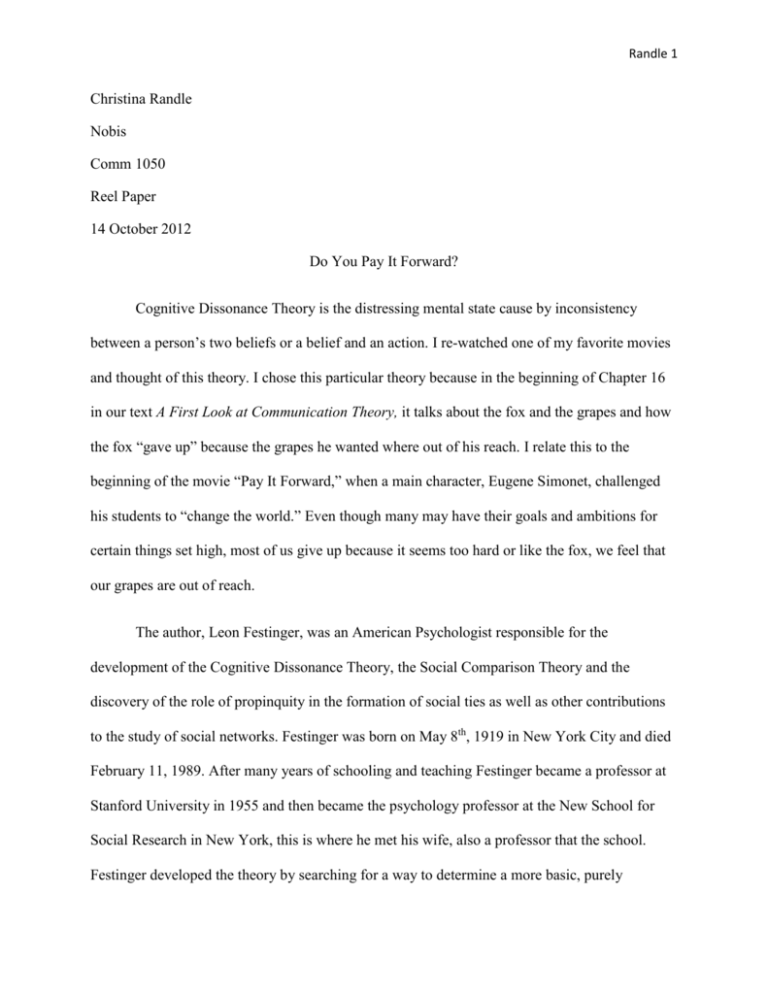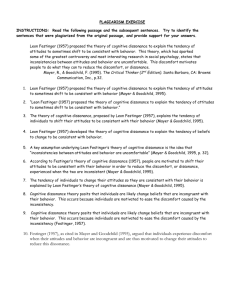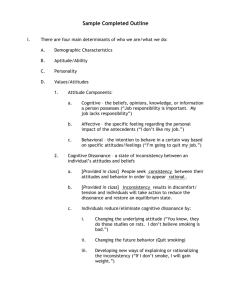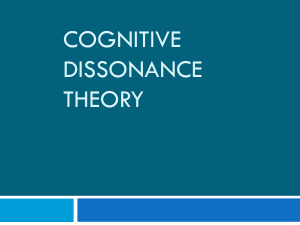Reel Paper - Christina Cooper
advertisement

Randle 1 Christina Randle Nobis Comm 1050 Reel Paper 14 October 2012 Do You Pay It Forward? Cognitive Dissonance Theory is the distressing mental state cause by inconsistency between a person’s two beliefs or a belief and an action. I re-watched one of my favorite movies and thought of this theory. I chose this particular theory because in the beginning of Chapter 16 in our text A First Look at Communication Theory, it talks about the fox and the grapes and how the fox “gave up” because the grapes he wanted where out of his reach. I relate this to the beginning of the movie “Pay It Forward,” when a main character, Eugene Simonet, challenged his students to “change the world.” Even though many may have their goals and ambitions for certain things set high, most of us give up because it seems too hard or like the fox, we feel that our grapes are out of reach. The author, Leon Festinger, was an American Psychologist responsible for the development of the Cognitive Dissonance Theory, the Social Comparison Theory and the discovery of the role of propinquity in the formation of social ties as well as other contributions to the study of social networks. Festinger was born on May 8th, 1919 in New York City and died February 11, 1989. After many years of schooling and teaching Festinger became a professor at Stanford University in 1955 and then became the psychology professor at the New School for Social Research in New York, this is where he met his wife, also a professor that the school. Festinger developed the theory by searching for a way to determine a more basic, purely Randle 2 cognitive level, the origin of such pressures. He then pushed the idea as far as it could go by examining and testing its implications. In the end he ended up closing his laboratory and moving forward, not knowing that his idea worked and made a huge impact on the psychological community. There are many specific scenes in the movie that pertain to this theory. The first one I listed above, the second one was when the main character in the film, Trevor McKinney, brought home a homeless man, attempting to “pay it forward” for an assignment he was given in school. Even though Trevor’s cognitive dissonance was at a level where he could chose to help people and make an impact in someone’s life his mother, Arlene McKinney, did not have such an open mind. She was quick to judge the homeless man and even though she was so kind hearted and seemed to be one that would help anyone who needed it she took a stand and kicked him out without thinking about her cognitive dissonance. I believe that she had a form of Selective Exposure because she avoided any information given to her by her son about his new friend, the homeless man. Another example in the film was when the teacher, Mr. Simonet, told the student to “change the world,” but yet he could not change his own world in which he lived. Mr. Simonet was a very outgoing teacher at school, but when he was not in a school setting he seemed to shut down a little and put his guard up. He was a victim in a fire and was burned very badly. Because of this he was self-conscious and he wouldn’t let himself get close to anyone outside of a school setting. I am using him as an example because for so long in the movie he did not take his own advice, Trevor did but he did not. In the end of the film he vowed his love for Arlene and took that leap of faith to “change the world.” I believe that he experienced Festinger’s process model of cognitive dissonance, because he went through each step; attitude behavior inconsistency, dissonance created, attitude change and the dissonance reduced. Randle 3 The director of the film “Pay It Forward” was a woman named Mimi Leder. The message that she was trying to convey was that everyone should try to help one another and anyone can make a difference. She also included the drama of the adults with abuse and being selfconscious. She incorporated the alcoholism of the mother and how that affected her son. Comparing this film with the dissonance theory stuck out to me and fit the best. I believe that the director did indeed know about the Cognitive Dissonance Theory and incorporated it into the film. I couldn’t have thought of a better theory for this film. Every time I watch this film my heart sinks at the end when the main character, a child, dies. He was such an amazing kid with an incredible spirit and attempts to help others. This film changed my perspective on human communication because this little boy in the film made a huge nationwide impact by doing something nice for someone else and asking them to pay it forward to three other people. In the film, his idea made it to the east coast. It has taught me that no matter what, we should always try and help another even though we may second guess it. Our cognitive dissonance can be used in such an amazing way if we just take the leap of faith to use it in the right way. I am not saying that we should go out and hand homeless people money on the streets, but if you see someone in need, how hard would it be to buy them a sandwich or to ask them how they are and how their day is going? We need to start using our cognitive thinking to assess what we feel is the right and honest thing to do in a situation to put others before ourselves. The main points of this theory are the four main parts of processing the cognitive dissonance theory. First to recognize your attitude/behavior inconsistency then to see the dissonance you have created. After that, you change your attitude toward a certain thing or person and you finally reduce your dissonance and move on. I applied this to the film in all the Randle 4 main characters. First the mother with her alcoholism, she went through all of these steps struggling with it and in the end chose to change for herself and those around her, especially her son. The second example of this processing of the theory was the teacher which I explained above and also the young boy who really made a difference. Now someone that I need to also include is the young boy who ended up killing the main character, Trevor McKinney. This young boy was a little older than Trevor, and he chose to not change is cognitive dissonance. He even stabbed Trevor with the knife that he had stolen from Trevor in the beginning of the film. That was something that I found very symbolic and unjust. This part of the film literally ripped my heart out because he was such a smart, talented, kind and sweet little boy. He was only trying to help his friend from being bullied, and he ended up dying. I think that this teaches us that we need to make sure that we need to pick and choose our battles with the choses that we make both mentally and physically. If not, we to, could “be stabbed.” In conclusion, the most memorable quote from this film was when the teacher, Eugene Simonet, challenged his class to “change the world.” Not many teachers will ask this of their students, and I think that they should. This movie and this theory have taught me so much about what I think about doing and what I chose to do in my life. Even though sometimes I am way too quick to judge someone or something I need to remember to take a step back and to reevaluate my life and to challenge myself every day to help others and to do “the unthinkable.” Randle 5 Works Cited Festinger, Leon. Cognitive Dissonance Theory. 1957. A First Look At Communication Theory Seventh Edition 11 October 2012 Festinger, Leon, Henry W. Riecken, & Stanley Schachter, When Prophecy Fails: A Social and Psychological Study of a Modern Group that Predicted the End of the World (University of Minnesota Press; 1956). 11 October 2012 Festinger, Leon. 1954. A theory of social comparison processes. Hum. Relations 7:117-40 Leder, Mimi. Pay It Forward. Released in theaters October 20, 2000. 11 October 2012








